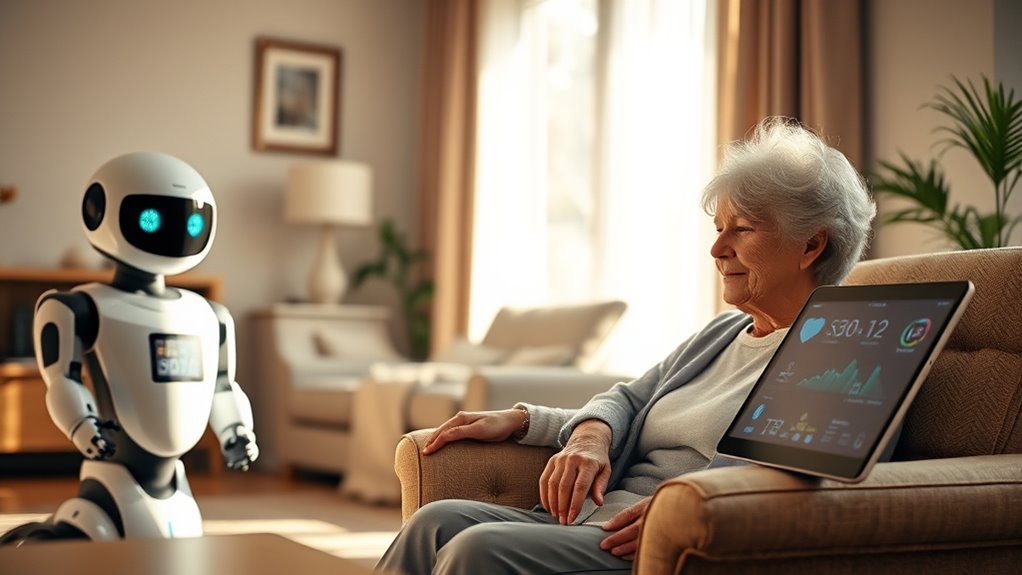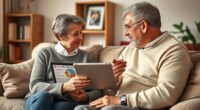Technology makes caregiving easier by offering smart home devices that monitor safety and health, voice-activated systems for quick communication, and remote tools like GPS trackers and video calls that keep loved ones connected. Automated medication reminders, fall detection, and emergency response systems help guarantee safety and independence. With these innovative solutions, you can manage daily tasks more efficiently while providing peace of mind. Keep going to discover how these tools can transform your caregiving approach.
Key Takeaways
- Remote activity monitoring and fall detection devices provide real-time alerts, reducing response times and enhancing safety.
- Voice-activated assistants enable hands-free communication and emergency assistance, supporting independence.
- Automated routines and reminders help seniors maintain daily schedules with minimal caregiver intervention.
- Secure online platforms allow caregivers to remotely access health data and activity logs for proactive care.
- Wireless sensors and environmental monitors create a comprehensive safety network, alerting caregivers to unusual behaviors or hazards.
Smart Home Devices for Safety and Comfort
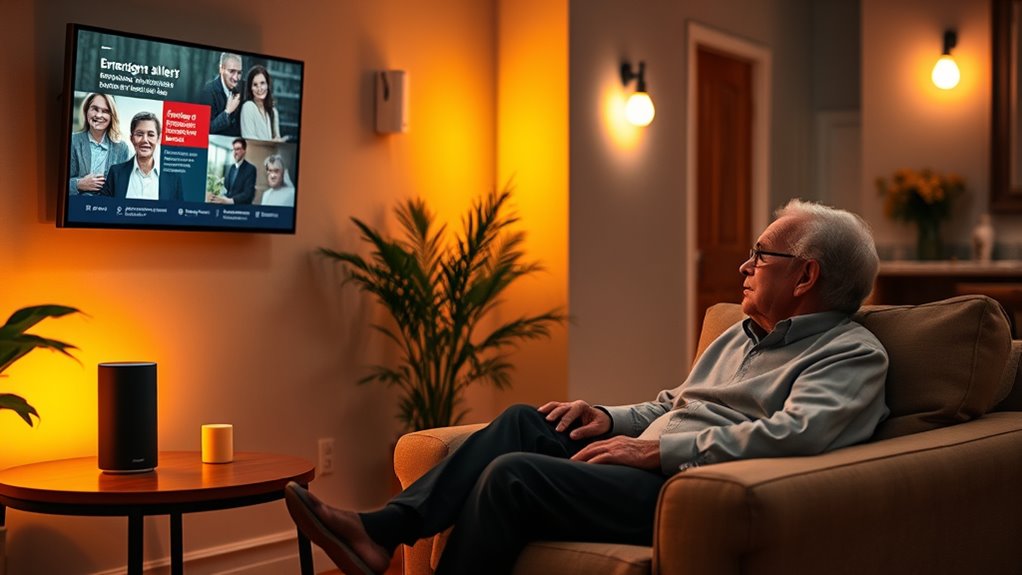
Smart home devices play a vital role in enhancing safety and comfort for seniors living independently. These devices, like smart thermostats and lighting systems, can be programmed to follow seniors’ routines, making daily life easier and safer. Vetted technology ensures reliable performance and security in these systems.
Automated door locks and security alarms offer keyless entry and enable caregivers to monitor homes remotely, reducing unauthorized access risks. Surveillance cameras let caregivers check in on loved ones without being physically present, providing peace of mind.
Voice-activated assistants, such as Amazon Echo or Google Home, allow seniors to control devices, receive reminders, and call for help using simple voice commands. Incorporating home automation can further streamline daily tasks and reduce the potential for accidents.
Additionally, smart home technology can automatically turn off appliances or trigger emergency alerts if it detects unusual activity, further boosting safety for seniors living alone. The integration of smart technology promotes proactive safety measures and enhances peace of mind for families. Incorporating mind-body connection principles can also enhance overall well-being by reducing stress and promoting relaxation in everyday routines.
Smart home integration is making it increasingly easier for caregivers to monitor and manage home safety remotely, ensuring overall peace of mind for families.
Monitoring Solutions to Keep Loved Ones Healthy
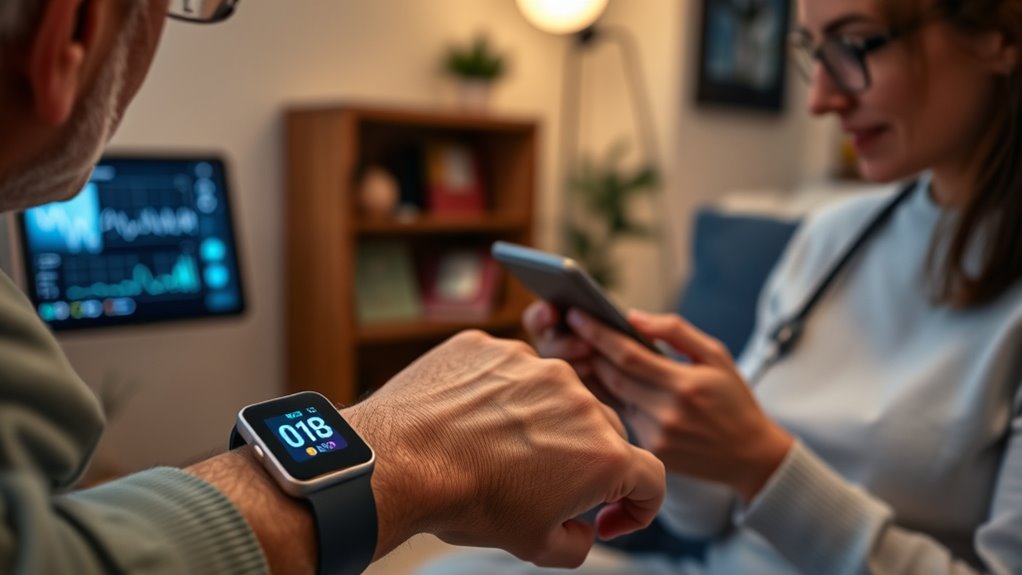
Monitoring solutions like remote activity trackers and health data devices keep you informed about your loved one’s well-being in real time. Fall detection technology quickly alerts you and emergency services if needed, providing peace of mind. These tools help you stay proactive and ensure timely care without constant in-person visits. Incorporating smart capabilities into traditional decor can enhance the usability and aesthetic appeal of your caregiving setup. For instance, choosing devices with wearable technology can seamlessly blend into your loved one’s daily environment, making monitoring less intrusive. Additionally, integrating air purifier features can improve indoor air quality, supporting respiratory health and overall well-being.
Remote Activity Monitoring Tools
Remote activity monitoring tools enable caregivers to keep a close eye on their loved ones’ health and safety without being physically present. These systems use remote monitoring, such as wireless sensors and motion detectors, to detect activity and alert you of any unusual behavior. They can also help promote digital literacy by providing insights into health patterns and encouraging informed decision-making. Family caregivers can access real-time data on home activity, including door openings, bed occupancy, and sleep patterns, through secure online platforms. Activity detection helps identify potential health issues early, like sleep disturbances or decreased mobility. Fall detection technology, including wearable devices and environmental sensors, automatically notifies you or emergency services if a fall occurs.
Health Data Tracking Devices
Have you ever wondered how loved ones can stay healthy and safe without constant supervision? Health data tracking devices make this possible by providing real-time health monitoring of essential signs like heart rate, blood pressure, and oxygen levels.
Wearable trackers, such as smartwatches, continuously gather this data, helping you stay informed about their well-being. These devices also enable continuous health monitoring, ensuring timely detection of irregularities. Additionally, many devices now feature real-time alerts that notify both caregivers and users immediately when abnormal readings are detected.
Fall detection devices automatically alert caregivers or emergency services if a fall occurs, reducing response times and injury risks.
These devices also log symptoms, medication adherence, and physical activity through integrated mobile apps, offering a thorough view of health.
The remote data transmission allows healthcare providers to monitor your loved ones’ health proactively, enabling timely interventions and better management of chronic conditions, all while giving you peace of mind.
Regular use of health data devices can also help identify indoor air quality issues that might affect overall health, further supporting a comprehensive approach to well-being.
Fall Detection Technologies
Fall detection technologies have revolutionized how you protect loved ones who wish to maintain their independence. These systems provide reliable monitoring for the elderly, ensuring their safety without being intrusive.
Wearable devices like pendants and smartwatches, such as the Apple Watch, can automatically alert caregivers within seconds of a fall, reducing response times. Advanced fall detection systems use sensors to distinguish between real falls and normal movements, minimizing false alarms and ensuring help arrives promptly.
Some monitoring solutions incorporate environmental sensors and motion detectors to identify falls or unusual inactivity, offering holistic safety coverage. Automated alerts are sent via calls, texts, or app notifications, enabling immediate intervention no matter where you are. Additionally, understanding essential oils for fall prevention can contribute to overall well-being and balance, further supporting safe independence.
Furthermore, integrating AI-powered monitoring can enhance detection accuracy and provide proactive alerts, improving overall safety. This technology supports safe, independent living while keeping your loved ones protected.
Medication Management Tools for Better Compliance
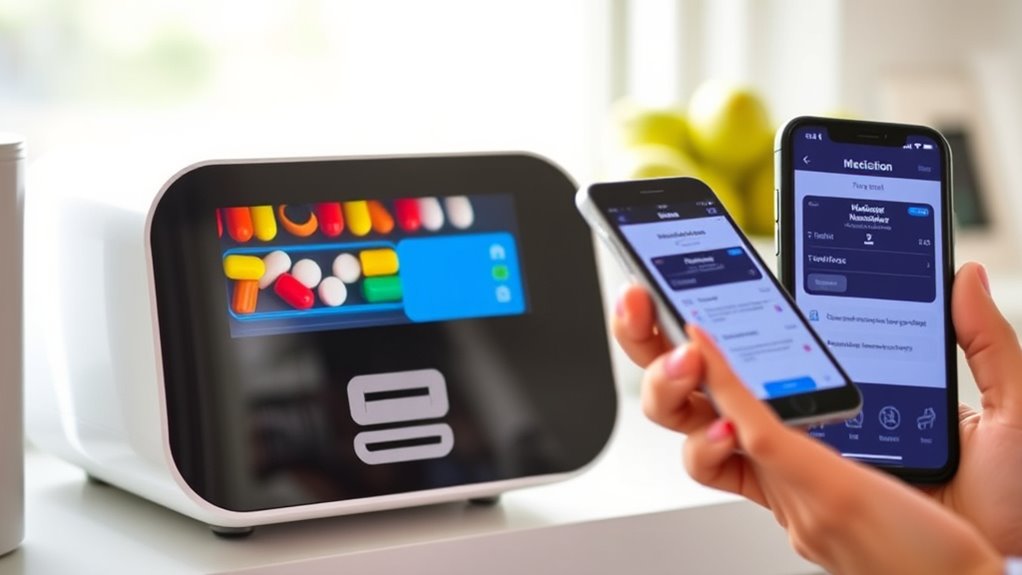
Medication management tools play a crucial role in ensuring seniors take their prescriptions correctly and on time. These tools improve adherence by offering reminders through apps, text alerts, or visual signals.
Medication tools help seniors take prescriptions correctly and on time, improving safety and independence.
Automated dispensers like MedMinder and TabSafe dispense pills at scheduled times, reducing errors and supporting independence.
Wireless pill bottles with sensors track medication adherence and notify caregivers if doses are missed or delayed, providing peace of mind.
Digital reminders via smartphone apps such as MediSafe help seniors stay on schedule and log adherence data for medical reviews.
Online portals linked to these devices enable remote monitoring of medication intake and inventory, allowing caregivers to maintain oversight effortlessly.
Additionally, incorporating smart technology into medication management can further enhance accuracy and ease of use for seniors and caregivers alike.
These innovations make medication management more reliable, safe, and less stressful for both seniors and their caregivers.
Voice-Activated Technology to Enhance Communication
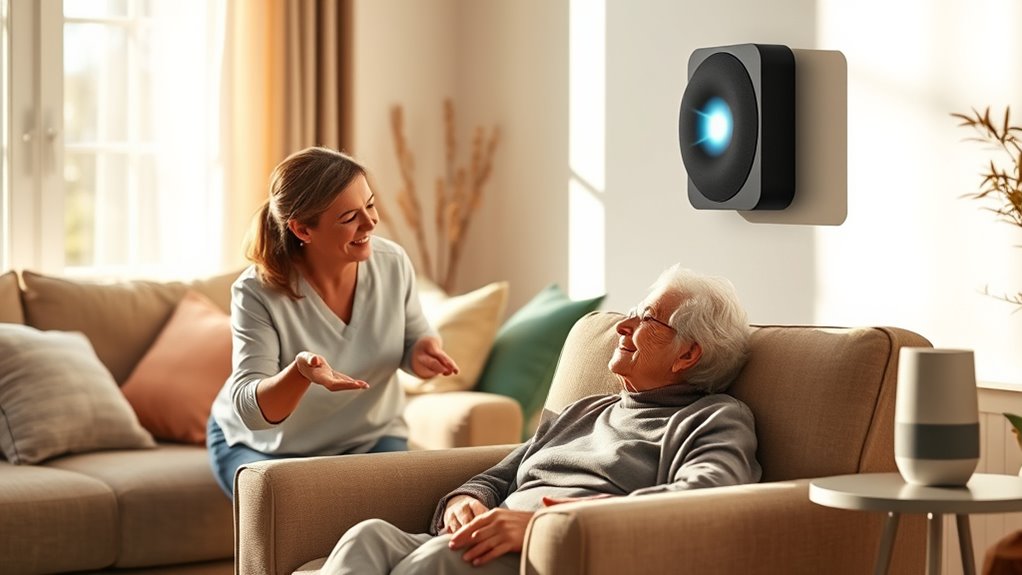
Voice-activated devices make communication easier by allowing you to call loved ones or emergency services with just your voice. They also send automatic reminders for medications and daily routines, helping you stay on track.
These tools reduce the need for manual interaction, supporting independence and safety effortlessly.
Hands-Free Emergency Assistance
Hands-free emergency assistance technology allows seniors to summon help effortlessly by simply speaking a command, eliminating the need for manual input. With voice-activated devices like Amazon Echo and Google Home, your senior loved ones can quickly request emergency help anytime they need it.
These smart speakers can be preprogrammed to send alerts or contact emergency contacts automatically when a distress phrase is spoken, providing immediate support. Additionally, understanding the importance of high refresh rates and low input lag can enhance the overall responsiveness of smart home devices, making interactions more seamless. Recognizing emotional manipulation behaviors can also help caregivers better understand and address potential safety concerns related to technology reliance.
Voice-first technology is especially helpful for seniors with limited mobility or dexterity, ensuring they can access emergency services without pressing buttons. Integrating these devices with medical alert systems adds an extra layer of safety, giving peace of mind that help is just a voice command away and improving safety outcomes for at-risk seniors. Moreover, advancements in smart home connectivity help ensure these devices function reliably and quickly when needed.
Simplified Daily Reminders
Simplified daily reminders using voice-activated technology make it easier for seniors to stay on top of important tasks without relying on manual prompts. With simple voice commands, you can set medication, appointment, and activity reminders through devices like Amazon Echo or Google Home. These smart assistants can automatically initiate daily check-ins or prompts, ensuring your senior loved ones stay on schedule. A high-performance system ensures reliability and efficiency, making these features even more dependable. Additionally, ensuring regulatory compliance in device use protects user privacy and safety. Plus, family members and caregivers can remotely program and update reminders, providing flexible support in home care. Using voice commands reduces the hassle of manual device operation, especially for seniors with mobility or cognitive challenges. This technology not only promotes independence but also leverages ethical hacking principles to safeguard user data and device security, thus building trust in the system. To further enhance safety, integrating cybersecurity measures helps prevent unauthorized access and potential data breaches. This technology not only promotes independence but also improves medication adherence and routine consistency.
Remote Caregiving With Video Calls and GPS Tracking
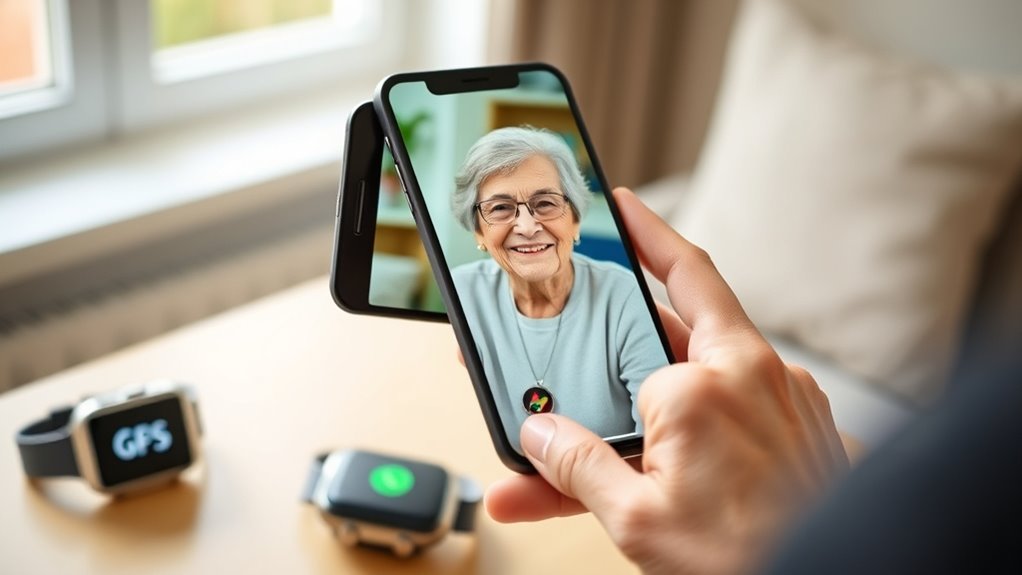
Remote caregiving has become more effective with the integration of video calls and GPS tracking technologies, allowing you to stay connected and monitor loved ones from afar. Video calls enable you to visually check in, spot non-verbal cues, and detect health issues early, supporting proactive care. Recognizing angel numbers can also provide spiritual reassurance and guidance during challenging times. GPS tracking devices embedded in smartwatches, pendants, or smartphones provide real-time location sharing, helping you quickly locate loved ones with dementia or mobility challenges. These portable devices are designed to be unobtrusive and easy for seniors to carry, ensuring continuous safety updates. Incorporating wearable technology can further enhance the effectiveness of remote caregiving by providing additional health data and activity monitoring. Understanding emotional support strategies can also help caregivers better address the psychological needs of their loved ones. Combining video calls with GPS tracking creates a thorough remote caregiving solution that enhances safety, fosters engagement, and offers peace of mind. This technology helps you stay connected and confident in your loved ones’ well-being.
Emergency Response Systems for Prompt Assistance
Emergency response systems provide seniors with quick access to help during emergencies, giving both them and their caregivers peace of mind. With these systems, you can guarantee prompt assistance when needed most.
Modern devices feature:
- Emergency response buttons on medical alert pendants or wristbands for immediate help.
- Falls detection that automatically alerts emergency services without user intervention.
- Medical alert systems with real-time tracking, enabling responders to locate seniors quickly.
- Smartwatches like the Apple Watch, which combine fall detection and emergency calling discreetly.
These tools reduce response times, prevent serious injuries, and support independent living.
Whether through automatic alerts or GPS-enabled devices, emergency response systems are crucial for ensuring safety and peace of mind for everyone involved.
Digital Apps Supporting Daily Care Tasks
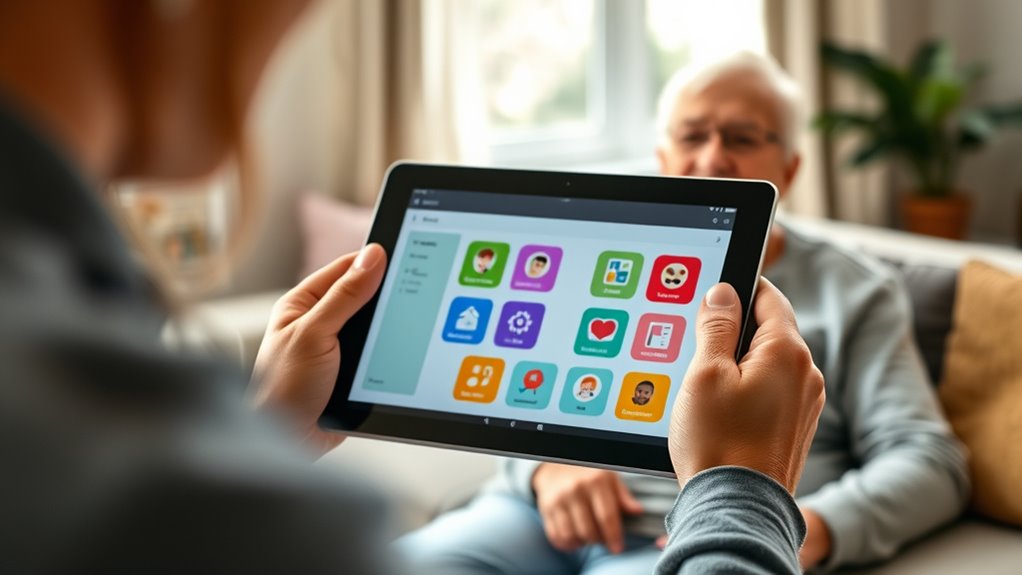
Digital apps supporting daily care tasks have become essential tools for caregivers and seniors alike, streamlining routines and reducing errors. These apps help you manage medication schedules, ensuring medications are taken on time and according to care plans.
They also feature activity tracking and journaling, allowing you to monitor health and behavior remotely. Customizable reminders keep you and your loved ones on schedule for appointments, medication, and daily activities.
Many apps integrate with wearable devices to log vital signs and physical activity, offering a holistic health overview in one platform. User-friendly interfaces and scalable options make these apps accessible regardless of tech experience, helping maintain independence while ensuring adherence to care routines.
They simplify complex caregiving tasks, making daily management more efficient and reliable.
Home Automation for Convenience and Security
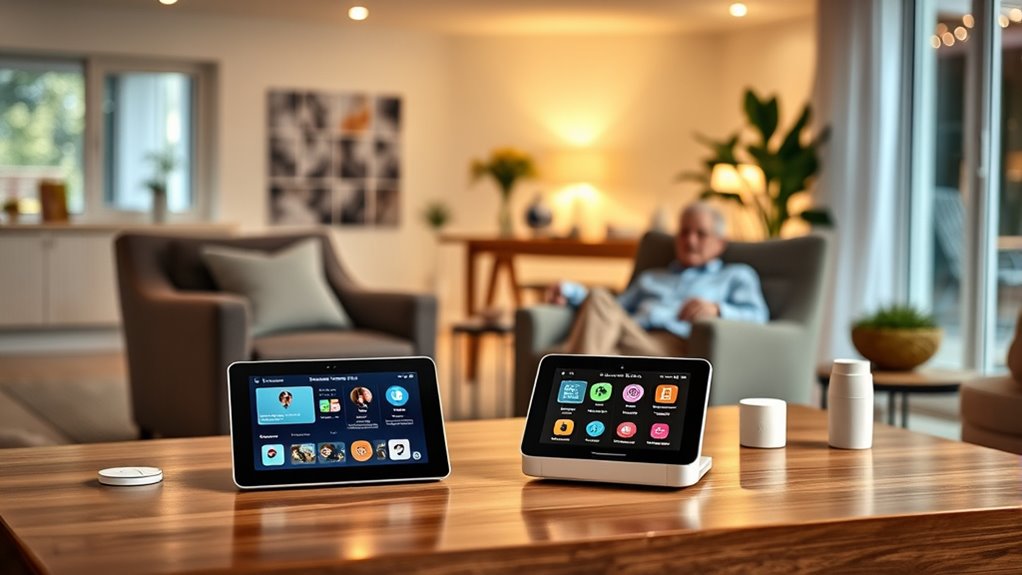
Home automation systems have transformed daily living by making routines more convenient and enhancing safety, especially for seniors aging in place. With smart devices, you can control your environment easily, providing peace of mind for caregivers and loved ones.
These systems include:
- Smart thermostats that learn your schedule to optimize comfort and energy use.
- Automated lighting that activates based on presence or time, reducing fall risks.
- Automated door locks and security alarms you can control remotely, boosting safety.
- Surveillance cameras that let caregivers check on loved ones and property from anywhere.
Tips for Choosing the Right Caregiving Technologies

Choosing the right caregiving technologies starts with understanding the specific needs of your loved one. Focus on mobility, medication management, or emergency response to select suitable solutions. Prioritize devices with user-friendly interfaces and strong accessibility features, so your loved one can navigate easily. Guarantee compatibility with your existing smart home system for seamless automation and integration. Also, review privacy policies and security measures to protect sensitive data. Comparing costs, subscription plans, and vendor support helps ensure long-term affordability. Here’s a quick guide:
| Consideration | Key Focus |
|---|---|
| Accessibility | Intuitive interfaces and clear instructions |
| Privacy & Security | Data protection and secure communication |
| Compatibility & Costs | Seamless integration and affordability |
Frequently Asked Questions
What Are the Digital Tools for Caregivers?
You’re wondering about digital tools for caregivers. These include smartphone apps like MediSafe for medication reminders and CareZare for scheduling.
Online platforms such as Lotsa Helping Hands and Care.com help you coordinate tasks and find respite providers.
Wearables like GPS watches and fall detectors keep loved ones safe remotely.
Health apps and sensors monitor essential signs, while voice assistants like Alexa offer hands-free reminders and emergency help, making caregiving more manageable.
How Technology Could Be a Solution to Caregiver Shortage for Seniors?
You see, technology can address caregiver shortages by enabling you to monitor seniors remotely through devices like motion sensors, fall detectors, and remote health monitoring tools.
These innovations let you oversee multiple seniors efficiently, reducing the need for constant in-person visits.
With digital communication and automated systems, you can coordinate care more effectively, ensuring seniors stay safe and well while you manage your workload better and fill staffing gaps.
What Are the 3 C’s of Caregiving?
The 3 C’s of caregiving are Compassion, Communication, and Consistency.
You show compassion by genuinely caring for the emotional and physical needs of your loved ones.
Clear communication helps you keep everyone informed and respectful.
Staying consistent with routines provides stability and safety.
Focusing on these principles helps you build trust, offer better support, and improve the overall well-being of those you care for.
How Is Technology Used in Elderly Care?
You might think technology complicates elderly care, but it actually streamlines it. You use devices like wearables to monitor essential signs and detect falls, ensuring safety. Smart home systems let you control lighting and locks remotely, helping seniors stay independent. Telemedicine platforms connect you to healthcare providers without leaving home, and medication management tools keep track of prescriptions. GPS devices further enhance safety by providing real-time location updates.
Conclusion
Embracing caregiving technology bridges the gap between independence and safety, offering peace of mind. While these devices provide security and ease, they can’t replace the warmth of human connection. As you rely on smart solutions for safety, remember that compassion and presence remain irreplaceable. Balancing innovation with heartfelt care creates a nurturing environment where your loved ones feel both protected and loved, proving that technology enhances, but never replaces, genuine human connection.
